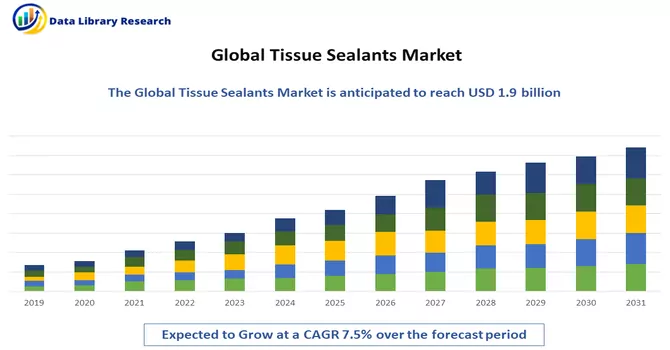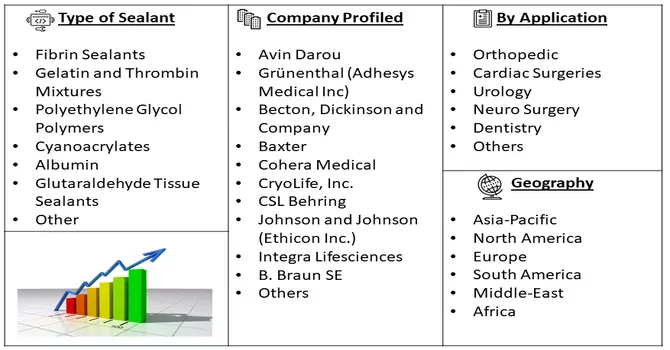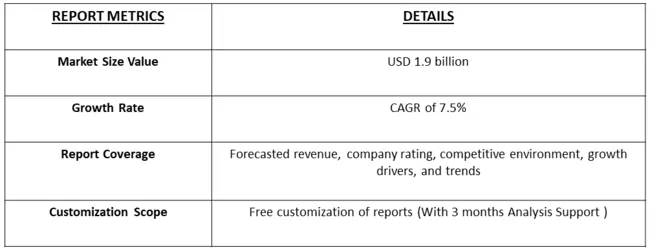The tissue sealants market is currently valued at USD 1.9 billion is expected to register a CAGR of 7.5% during the forecast period, 2024-2031.

Get Complete Analysis Of The Report - Download Free Sample PDF
The tissue sealants market is witnessing significant growth driven by advancements in surgical techniques, rising prevalence of chronic diseases requiring surgical interventions, and increasing adoption of minimally invasive procedures. Tissue sealants, also known as surgical adhesives or tissue glues, are biocompatible substances used to seal or close wounds, reduce bleeding, and promote tissue healing during surgical procedures. These sealants offer several advantages over traditional methods such as sutures and staples, including faster healing, reduced risk of infection, and improved cosmetic outcomes. Moreover, the growing geriatric population and rising demand for aesthetic and cosmetic surgeries are further propelling market growth.
Additionally, the development of innovative sealant formulations with enhanced adhesive properties, biodegradability, and tissue compatibility is driving market expansion. However, challenges such as stringent regulatory requirements, high costs associated with advanced sealant products, and potential risks of allergic reactions or tissue damage may hinder market growth to some extent. Nonetheless, ongoing research and development activities aimed at improving the safety and efficacy of tissue sealants are expected to drive continued market growth in the coming years. One of the key growth driving factors for the tissue sealants market is the increasing adoption of minimally invasive surgical procedures. Minimally invasive techniques, including laparoscopic and robotic-assisted surgeries, have gained popularity due to their numerous benefits such as smaller incisions, reduced trauma to surrounding tissues, faster recovery times, and shorter hospital stays. Tissue sealants play a crucial role in these procedures by providing effective hemostasis and sealing of tissue layers, thereby facilitating better wound healing and minimizing postoperative complications. Moreover, the growing prevalence of chronic diseases requiring surgical interventions, coupled with the rising geriatric population globally, is further driving the demand for tissue sealants. Additionally, advancements in sealant formulations, such as the development of bioresorbable and biocompatible materials, are enhancing their effectiveness and expanding their applications across various surgical specialties, thereby contributing to market growth.
Market Segmentation: The Tissue Sealants Market is segmented by Type of Sealant (Fibrin Sealants, Gelatin and Thrombin Mixtures, Polyethylene Glycol Polymers, Cyanoacrylates, Albumin, and Glutaraldehyde Tissue Sealants, and Other Types of Sealants), Application (Orthopedic, Cardiac Surgeries, Urology, Neuro Surgery, Dentistry, and Others), and Geography (North America, Europe, Asia-Pacific, Middle East and Africa, and South America). The report offers the value (in USD million) for the above segments.

For Detailed Market Segmentation - Download Free Sample PDF
In the tissue sealants market, several notable trends are shaping the industry landscape. One significant trend is the increasing preference for combination products that offer both sealing and hemostatic properties. Manufacturers are developing innovative sealants that incorporate other biologically active substances such as thrombin, collagen, fibrinogen, and platelet-rich plasma to enhance the efficacy of tissue repair and promote faster healing. Additionally, there's a growing emphasis on the development of bioadhesive sealants that can adhere securely to both wet and dry surfaces, providing better sealing performance in challenging surgical environments. Moreover, the rise of advanced delivery systems, such as spray applicators and patch-based sealants, is facilitating easier and more precise application of tissue sealants during surgical procedures. Furthermore, the market is witnessing increasing research and development efforts aimed at creating sealants with improved biocompatibility, reduced immunogenicity, and longer-lasting effects, catering to the evolving needs of surgeons and patients alike. Overall, these trends are expected to drive continued innovation and growth in the tissue sealants market.
Market Drivers:
Increasing Surgical Procedures:
The growing number of surgical procedures worldwide, including general surgery, orthopedic surgery, cardiovascular surgery, and cosmetic surgery, is driving the demand for tissue sealants. As surgical volumes rise due to factors such as aging populations, increasing prevalence of chronic diseases, and advancements in surgical techniques, there is a corresponding need for effective hemostatic and sealing solutions to minimize bleeding, reduce surgical time, and enhance patient outcomes.
Rising Adoption of Minimally Invasive Surgeries:
The shift towards minimally invasive surgical techniques is fueling the demand for tissue sealants. Minimally invasive procedures offer several benefits over traditional open surgeries, including smaller incisions, reduced trauma to surrounding tissues, faster recovery times, and shorter hospital stays. Tissue sealants play a crucial role in sealing small incisions, puncture sites, and tissue layers in minimally invasive surgeries, contributing to improved patient recovery and satisfaction. As healthcare providers increasingly embrace minimally invasive approaches across various medical specialties, the demand for tissue sealants is expected to grow steadily.
Market Restraints:
One significant market restraint for tissue sealants is the stringent regulatory requirements and approval processes governing their development and commercialization. The tissue sealants industry operates within a highly regulated framework, with stringent standards imposed by regulatory authorities such as the FDA (Food and Drug Administration) in the United States and the EMA (European Medicines Agency) in Europe. Meeting these regulatory requirements involves conducting extensive preclinical and clinical studies to demonstrate safety, efficacy, and product quality, which can be time-consuming and expensive. Additionally, gaining regulatory approval for new tissue sealant products or expanding indications for existing ones often requires substantial investment in research and development. Delays or failures in obtaining regulatory clearance can significantly impede market entry and product commercialization efforts, hindering growth opportunities for tissue sealant manufacturers. Moreover, compliance with evolving regulatory standards and post-market surveillance requirements adds complexity and cost to the development and marketing of tissue sealants, posing challenges for industry players.
The COVID-19 pandemic has had a mixed impact on the tissue sealants market. On one hand, the increased focus on healthcare infrastructure and the rising number of surgeries, including those related to COVID-19 treatment and elective procedures postponed during the pandemic, have led to a surge in demand for tissue sealants. These products are vital for achieving hemostasis and promoting tissue repair in surgical procedures, which have become more frequent due to the pandemic. On the other hand, disruptions in the global supply chain, logistical challenges, and temporary closures of healthcare facilities have posed obstacles to the production and distribution of tissue sealants. Moreover, economic uncertainties and budget constraints in healthcare spending in some regions have led to deferred or canceled elective surgeries, affecting the demand for tissue sealants. Overall, while the immediate impact of the pandemic has driven demand for tissue sealants, uncertainties surrounding healthcare systems' capacity and financial constraints may influence market dynamics in the long term.
Segmental Analysis:
Polyethylene Glycol Polymers Segment is Expected to Witness Significant Growth Over the Forecast Period
Polyethylene glycol (PEG) polymers play a crucial role in the tissue sealants market, particularly in the development of bioadhesive formulations. These polymers are biocompatible and can be modified to achieve desired adhesive properties, making them ideal for use in tissue sealants. PEG polymers are commonly used as crosslinkers in tissue sealant formulations, where they help create a strong, flexible, and biodegradable adhesive bond between tissues. The tissue sealants market benefits from the versatility and effectiveness of PEG polymers, which contribute to improved patient outcomes and the development of innovative tissue sealant products.
Dentistry Segment is Expected to Witness Significant Growth Over the Forecast Period
Dentistry is a field that has greatly benefited from the use of tissue sealants, particularly in the realm of oral surgery and dental procedures. Tissue sealants, also known as dental adhesives or dental sealants, are used to bond and seal tissues in the mouth, aiding in the healing process and preventing infections. These sealants are commonly used in procedures such as tooth fillings, root canals, and periodontal surgeries. One of the key benefits of tissue sealants in dentistry is their ability to create a barrier against bacteria and other pathogens. By sealing off the treated area, tissue sealants help reduce the risk of infection and promote faster healing. This is especially important in oral surgeries, where the risk of infection is high due to the presence of bacteria in the mouth. Tissue sealants also play a crucial role in restorative dentistry. They are used to bond dental materials such as fillings, crowns, and bridges to the natural tooth structure, providing a strong and durable bond. This helps ensure the longevity of dental restorations and prevents them from coming loose or falling out. Moreover, tissue sealants in dentistry are often used to seal pits and fissures in the teeth, particularly in children, to prevent cavities. By sealing off these vulnerable areas, tissue sealants help protect the teeth from decay and reduce the need for more invasive treatments such as fillings or root canals. Thus, tissue sealants play a vital role in dentistry, helping to promote healing, prevent infections, and improve the longevity of dental restorations. Their use has revolutionized dental procedures, making them safer, more effective, and more comfortable for patients.
North America Region is Expected to Witness Significant Growth Over the Forecast Period
North America is poised to lead the tissue sealants market, driven by several key factors. The region has witnessed a surge in bone and sports injuries, alongside a rise in hip and knee replacement surgeries. This trend is further fueled by a growing geriatric population, robust healthcare infrastructure, and heightened awareness among both individuals and healthcare professionals about available technologies. Moreover, North America boasts a strong presence of industry players and a high concentration of market stakeholders, further propelling market growth.
For instance, Canada reported 54,918 total knee replacement surgeries and 54,991 total hip replacement surgeries in 2020, as per the Organization for Economic Co-operation and Development (OECD) September 2022 update. The substantial burden of these surgeries is expected to drive demand for tissue sealants in the region. Additionally, the Centers for Disease Control and Prevention (CDC) reported that millions of older adults in the United States suffer from falls annually, with one in five falls resulting in serious injuries such as broken bones. Given that the geriatric population is more susceptible to injuries, this age group is likely to require tissue sealants for treatment, further boosting market growth. Furthermore, Statistics Canada's 2021 census revealed a significant elderly population in Canada, with approximately 7,021,430 individuals aged 65 years or above, comprising 3,224,680 males and 3,796,750 females. This large geriatric demographic indicates a high potential for tissue sealant utilization in the region, thereby driving market growth. In summary, with the confluence of these factors, the tissue sealants market is poised for significant growth in North America.

Get Complete Analysis Of The Report - Download Free Sample PDF
The analyzed market exhibits a high degree of fragmentation, primarily attributable to the presence of numerous players operating on both a global and regional scale. The competitive landscape is characterized by a diverse array of companies, each contributing to the overall market dynamics. This fragmentation arises from the existence of specialized solution providers, established industry players, and emerging entrants, all vying for market share. The diversity in market participants is underscored by the adoption of various strategies aimed at expanding the company presence. On a global scale, companies within the studied market are strategically positioning themselves through aggressive expansion initiatives. This often involves entering new geographical regions, targeting untapped markets, and establishing a robust global footprint. The pursuit of global expansion is driven by the recognition of diverse market opportunities and the desire to capitalize on emerging trends and demands across different regions. Simultaneously, at the regional level, companies are tailoring their approaches to align with local market dynamics. Regional players are leveraging their understanding of specific market nuances, regulatory environments, and consumer preferences to gain a competitive edge. This regional focus allows companies to cater to the unique needs of local clientele, fostering stronger market penetration. To navigate the complexities of the fragmented market, companies are implementing a range of strategies. These strategies include investments in research and development to stay at the forefront of technological advancements, mergers and acquisitions to consolidate market share, strategic partnerships for synergies, and innovation to differentiate products and services. The adoption of such multifaceted strategies reflects the competitive nature of the market, with participants continually seeking avenues for growth and sustainability. In essence, the high fragmentation in the studied market not only signifies the diversity of players but also underscores the dynamism and competitiveness that drive ongoing strategic maneuvers. As companies explore various avenues for expansion, the market continues to evolve, presenting both challenges and opportunities for industry stakeholders.
Some of the major players:
Recent Developments:
1) In 2022: The introduction of the Enseal X1 straight jaw tissue sealer by Ethicon is expected to significantly enhance the tissue sealants market. This innovative product offers stronger sealing capabilities, greater efficiency, and improved access to targeted tissue during various surgical procedures. These advancements are likely to increase the adoption of tissue sealants, as surgeons seek more effective and efficient tools for tissue sealing.
2) In 2022, Clariant's launch of 100% biobased surfactants, polyethylene glycols, in February 2022 is anticipated to have a positive impact on the tissue sealants market. These biobased surfactants offer a sustainable and environmentally friendly alternative to traditional polyethylene glycols, catering to the growing demand for eco-friendly products. This development is expected to drive the adoption of polyethylene glycol-based tissue sealants, further expanding the market. Overall, these advancements in tissue sealing technology and materials are poised to boost the tissue sealants market by offering surgeons and healthcare providers more effective, efficient, and sustainable solutions for tissue sealing in various surgical procedures.
Q1. What is the current Tissue Sealants Market size?
As per Data Library Research the tissue sealants market is currently valued at USD 1.9 billion.
Q2. What is the Growth Rate of the Tissue Sealants Market?
Tissue Sealants Market is expected to register a CAGR of 7.5% during the forecast period.
Q3. What are the factors driving the Tissue Sealants market?
Key factors that are driving the growth include the Increasing Surgical Procedures and Rising Adoption of Minimally Invasive Surgeries.
Q4. Who are the key players in Tissue Sealants market?
Some key players operating in the market include
Data Library Research are conducted by industry experts who offer insight on industry structure, market segmentations technology assessment and competitive landscape (CL), and penetration, as well as on emerging trends. Their analysis is based on primary interviews (~ 80%) and secondary research (~ 20%) as well as years of professional expertise in their respective industries. Adding to this, by analysing historical trends and current market positions, our analysts predict where the market will be headed for the next five years. Furthermore, the varying trends of segment & categories geographically presented are also studied and the estimated based on the primary & secondary research.
In this particular report from the supply side Data Library Research has conducted primary surveys (interviews) with the key level executives (VP, CEO’s, Marketing Director, Business Development Manager and SOFT) of the companies that active & prominent as well as the midsized organization
FIGURE 1: DLR RESEARH PROCESS

Extensive primary research was conducted to gain a deeper insight of the market and industry performance. The analysis is based on both primary and secondary research as well as years of professional expertise in the respective industries.
In addition to analysing current and historical trends, our analysts predict where the market is headed over the next five years.
It varies by segment for these categories geographically presented in the list of market tables. Speaking about this particular report we have conducted primary surveys (interviews) with the key level executives (VP, CEO’s, Marketing Director, Business Development Manager and many more) of the major players active in the market.
Secondary ResearchSecondary research was mainly used to collect and identify information useful for the extensive, technical, market-oriented, and Friend’s study of the Global Extra Neutral Alcohol. It was also used to obtain key information about major players, market classification and segmentation according to the industry trends, geographical markets, and developments related to the market and technology perspectives. For this study, analysts have gathered information from various credible sources, such as annual reports, sec filings, journals, white papers, SOFT presentations, and company web sites.
Market Size EstimationBoth, top-down and bottom-up approaches were used to estimate and validate the size of the Global market and to estimate the size of various other dependent submarkets in the overall Extra Neutral Alcohol. The key players in the market were identified through secondary research and their market contributions in the respective geographies were determined through primary and secondary research.
Forecast Model
